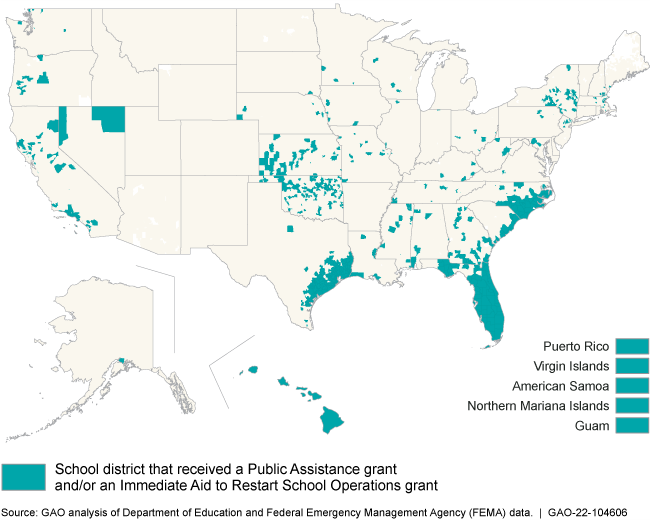Disaster Recovery: School Districts in Socially Vulnerable Communities Faced Heightened Challenges after Recent Natural Disasters
Fast Facts
Natural disasters can be devastating for K-12 schools—especially in areas where people were already vulnerable.
Most school districts that received key federal recovery grants in the wake of 2017-2019 disasters had higher than average proportions of students from socially vulnerable groups (e.g., low-income families, kids with disabilities).
We looked at 5 school districts in socially vulnerable communities. District officials said that students who faced problems like housing instability or food insecurity had significant emotional trauma after disasters. They also said it was hard to access mental health care for these students.
School Districts that Received Key Federal Recovery Grants for 2017-19 Presidentially Declared Major Disasters

Highlights
What GAO Found
Most school districts that received key federal disaster recovery grants following 2017-2019 presidentially-declared major disasters had elevated proportions of students from certain socially vulnerable groups, according to GAO's analysis of federal data. Research shows that socially vulnerable groups—including children who are low income, minorities, English learners, or living with disabilities—are particularly susceptible to the adverse effects of disasters. School districts serving high proportions of children in these groups may need more recovery assistance compared to districts with less vulnerable student populations. The Federal Emergency Management Agency's (FEMA) Public Assistance program and the Department of Education's Immediate Aid to Restart School Operations (Restart) program may provide such assistance. GAO found that 57 percent of school districts receiving these key grants for 2017-2019 disasters served a higher than average proportion of students in two or more of these socially vulnerable groups, compared to 38 percent of all school districts nationwide.
Officials from five selected school districts in socially vulnerable communities described heightened challenges recovering from recent natural disasters. These challenges generally fell into four areas of recovery: emotional, academic, financial, and physical (see figure). For instance, officials said the disasters caused significant emotional trauma to students due to stressors including extended housing instability, food insecurity, parental job loss, and social disconnection. To address these needs, districts worked to obtain additional mental health and support services. But officials cited frequent challenges in doing so. For instance, officials in two rural districts said their communities lacked sufficient qualified mental health providers.
Key Aspects of School Recovery from a Natural Disaster or Emergency

Through its Restart grant program, Education helped support a range of school recovery efforts after 2017-2019 natural disasters, awarding nearly $940 million in six states and three U.S. territories. School districts used funds to make physical repairs, acquire portable classrooms, and provide mental health and academic services to students, among other things. Education also worked proactively to help applicants with urgent recovery needs, such as by advancing a portion of anticipated grant funding early to help jumpstart recovery projects. Through such efforts, the Restart program played a key role in helping schools resume operations and meet students' needs following disasters.
Why GAO Did This Study
Since 2017, over 300 presidentially-declared major disasters have occurred across all 50 states and all U.S. territories. Many of these disasters have had devastating effects on K-12 schools, including those in socially vulnerable communities for whom disaster recovery is more challenging.
The Additional Supplemental Appropriations for Disaster Relief Act of 2019 included provisions for GAO to audit issues related to certain recent disasters. This report reviews (1) the extent to which school districts that received key federal disaster recovery grants served students from selected socially vulnerable groups, (2) the recovery experiences of selected K-12 school districts in socially vulnerable communities, and (3) the extent to which Education's Restart program supports school disaster recovery.
GAO analyzed disaster-related data from FEMA and Education including data on Restart grants and program documentation, and reviewed relevant federal laws and agency guidance. GAO also collected information from five school districts in three states, selected for demographic diversity, elevated rates of social vulnerability in their community, and receipt of Restart grants. In addition, GAO interviewed officials from FEMA and Education.
For more information, contact Jacqueline M. Nowicki at (617) 788-0580 or nowickij@gao.gov.
